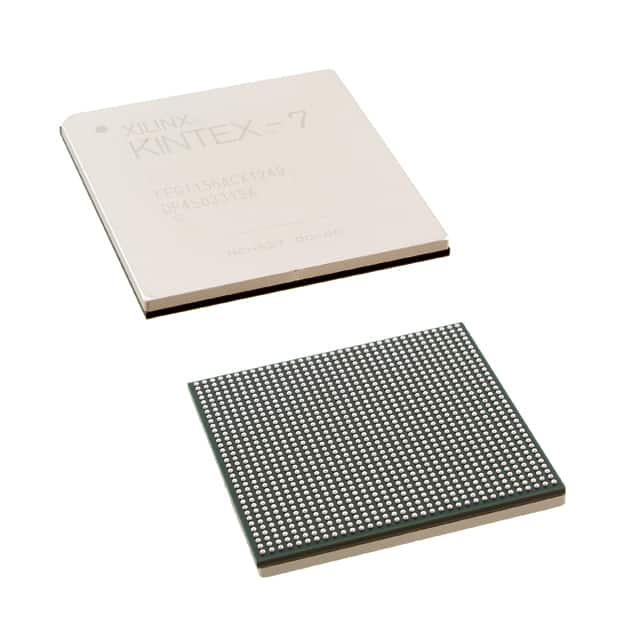Picture is only for your reference.
XC3S400-4PQG208C
AMD (Xilinx, Inc)
Product No:
XC3S400-4PQG208C
Manufacturer:
Package:
Tray
Batch:
-
Description:
Spartan®-3 Field Programmable Gate Array (FPGA) IC 141 294912 8064 208-BFQFP
Delivery:





Payment:
In Stock : Please Inquiry
Please send RFQ , we will respond immediately.









XC3S400-4PQG208C - Product Information
XC3S400-4PQG208C XILINX SPECIFICATION
The Spartan®-3 family of Field-Programmable Gate Arrays is specifically designed to meet the needs of high volume, cost-sensitive consumer electronic applications. The eight-member family offers densities ranging from 50,000 to 5,000,000 system gates, as shown in Table 1. The Spartan-3 family builds on the success of the earlier Spartan-IIE family by increasing the amount of logic resources, the capacity of internal RAM, the total number of I/Os, and the overall level of performance as well as by improving clock management functions. Numerous enhancements derive from the Virtex®-II platform technology. These Spartan-3 FPGA enhancements, combined with advanced process technology, deliver more functionality and bandwidth per dollar than was previously possible, setting new standards in the programmable logic industry.
Because of their exceptionally low cost, Spartan-3 FPGAs are ideally suited to a wide range of consumer electronics
applications, including broadband access, home networking, display/projection and digital television equipment.
The Spartan-3 family is a superior alternative to mask programmed ASICs. FPGAs avoid the high initial cost, the
lengthy development cycles, and the inherent inflexibility of conventional ASICs. Also, FPGA programmability permits design upgrades in the field with no hardware replacement necessary, an impossibility with ASICs
XC3S400-4PQG208C XILINX Features
• Low-cost, high-performance logic solution for high-volume, consumer-oriented applications
• Densities up to 74,880 logic cells
• SelectIO™ interface signaling
• Up to 633 I/O pins
• 622+ Mb/s data transfer rate per I/O
• 18 single-ended signal standards
• 8 differential I/O standards including LVDS, RSDS
• Termination by Digitally Controlled Impedance
• Signal swing ranging from 1.14V to 3.465V
• Double Data Rate (DDR) support
• DDR, DDR2 SDRAM support up to 333 Mb/s
• Logic resources
• Abundant logic cells with shift register capability
• Wide, fast multiplexers
• Fast look-ahead carry logic
• Dedicated 18 x 18 multipliers
• JTAG logic compatible with IEEE 1149.1/1532
• SelectRAM™ hierarchical memory
• Up to 1,872 Kbits of total block RAM
• Up to 520 Kbits of total distributed RAM
• Digital Clock Manager (up to four DCMs)
• Clock skew elimination
• Frequency synthesis
• High resolution phase shifting
• Eight global clock lines and abundant routing
• Fully supported by Xilinx ISE® and WebPACK™ software development systems
• MicroBlaze™ and PicoBlaze™ processor, PCI®, PCI Express® PIPE Endpoint, and other IP cores
• Pb-free packaging options
• Automotive Spartan-3 XA Family variant
| Device | System Gates | Equivalent Logic Cells | CLB Array (One CLB=Four slices) | Distributed RAM Bits(K=1024) | Block RAM Bits(K=1024) | Dedicated Multipliers | DCMs | Max. User I/O | Max. Differentical I/O Pairs | ||
| Rows | Columns | Total CLBs | |||||||||
| XC3S50 | 50K | 1728 | 16 | 12 | 192 | 12K | 72K | 4 | 2 | 124 | 56 |
| XC3S200 | 200K | 4320 | 24 | 20 | 480 | 30K | 216K | 12 | 4 | 173 | 776 |
| XC3S400 | 400K | 8064 | 32 | 28 | 896 | 56K | 288K | 16 | 4 | 264 | 116 |
| XC3S1000 | 1M | 17280 | 48 | 40 | 1920 | 120K | 432K | 24 | 4 | 391 | 175 |
| XC3S1500 | 1.5M | 29952 | 64 | 50 | 3328 | 208K | 576K | 32 | 4 | 487 | 221 |
| XC3S2000 | 2M | 46080 | 80 | 64 | 5120 | 320K | 720K | 40 | 4 | 565 | 270 |
| XC3S4000 | 4M | 62208 | 96 | 72 | 6912 | 432K | 1728K | 96 | 4 | 633 | 300 |
| XC3S5000 | 5M | 74880 | 104 | 80 | 8320 | 520K | 1872K | 104 | 4 | 633 | 300 |
XC3S400-4PQG208C XILINX Models Types
| Model 1 | Model 2 | Model 3 | Model 4 |
| Introduction and Ordering Information DS099 (v3.1) June 27, 2013 |
Functional Description DS099 (v3.1) June 27, 2013 |
DC and Switching Characteristics DS099 (v3.1) June 27, 2013 |
Pinout Descriptions DS099 (v3.1) June 27, 2013 |
• Introduction • Features • Architectural Overview • Array Sizes and Resources • User I/O Chart • Ordering Information |
• Input/Output Blocks (IOBs) • IOB Overview • SelectIO™ Interface I/O Standards • Configurable Logic Blocks (CLBs) • Block RAM • Dedicated Multipliers • Digital Clock Manager (DCM) • Clock Network • Configuration |
• DC Electrical Characteristics • Absolute Maximum Ratings • Supply Voltage Specifications • Recommended Operating Conditions • DC Characteristics • Switching Characteristics • I/O Timing • Internal Logic Timing • DCM Timing • Configuration and JTAG Timing |
• Pin Descriptions • Pin Behavior During Configuration • Package Overview • Pinout Tables • Footprints |
XC3S400-4PQG208C XILINX Architectural Overview
The Spartan-3 family architecture consists of five fundamental programmable functional elements:
• Configurable Logic Blocks (CLBs) contain RAM-based Look-Up Tables (LUTs) to implement logic and storage
elements that can be used as flip-flops or latches. CLBs can be programmed to perform a wide variety of logical
functions as well as to store data.
• Input/Output Blocks (IOBs) control the flow of data between the I/O pins and the internal logic of the device. Each IOB supports bidirectional data flow plus 3-state operation. Twenty-six different signal standards, including eight high-performance differential standards, are available as shown in Table 2. Double Data-Rate (DDR) registers are included. The Digitally Controlled Impedance (DCI) feature provides automatic on-chip terminations, simplifying board designs.
• Block RAM provides data storage in the form of 18-Kbit dual-port blocks.
• Multiplier blocks accept two 18-bit binary numbers as inputs and calculate the product.
• Digital Clock Manager (DCM) blocks provide self-calibrating, fully digital solutions for distributing, delaying, multiplying, dividing, and phase shifting clock signals.These elements are organized as shown in Figure 1. A ring of IOBs surrounds a regular array of CLBs. The XC3S50 has a single column of block RAM embedded in the array. Those devices ranging from the XC3S200 to the XC3S2000 have two columns of block RAM. The XC3S4000 and XC3S5000 devices have four RAM columns. Each column is made up of several 18-Kbit RAM blocks; each block is associated with a dedicated multiplier. The DCMs are positioned at the ends of the outer block RAM columns.
The Spartan-3 family features a rich network of traces and switches that interconnect all five functional elements,
transmitting signals among them. Each functional element has an associated switch matrix that permits multiple connections to the routing.

Figure 1: Spartan-3 Family Architecture
XC3S400-4PQG208C XILINX Configuration
Spartan-3 FPGAs are programmed by loading configuration data into robust reprogrammable static CMOS configuration latches (CCLs) that collectively control all functional elements and routing resources. Before powering on the FPGA, configuration data is stored externally in a PROM or some other nonvolatile medium either on or off the board. After applying power, the configuration data is written to the FPGA using any of five different modes: Master Parallel, Slave Parallel, Master Serial, Slave Serial, and Boundary Scan (JTAG). The Master and Slave Parallel modes use an 8-bit-wide SelectMAP port.
The recommended memory for storing the configuration data is the low-cost Xilinx Platform Flash PROM family, which includes the XCF00S PROMs for serial configuration and the higher density XCF00P PROMs for parallel or serial configuration.
XC3S400-4PQG208C XILINX I/O Capabilities
The SelectIO feature of Spartan-3 devices supports eighteen single-ended standards and eight differential standards as listed in Table 2. Many standards support the DCI feature, which uses integrated terminations to eliminate unwanted signal reflections.


XC3S400-4PQG208C XILINX Package Marking
Figure 2 shows the top marking for Spartan-3 FPGAs in the quad-flat packages. Figure 3 shows the top marking for Spartan-3 FPGAs in BGA packages except the 132-ball chip-scale package (CP132 and CPG132). The markings for the BGA packages are nearly identical to those for the quad-flat packages, except that the marking is rotated with respect to the ball A1 indicator. Figure 4 shows the top marking for Spartan-3 FPGAs in the CP132 and CPG132 packages.
The “5C” and “4I” part combinations may be dual marked as “5C/4I”. Devices with the dual mark can be used as either -5C or -4I devices. Devices with a single mark are only guaranteed for the marked speed grade and temperature range. Some specifications vary according to mask revision. Mask revision E devices are errata-free. All shipments since 2006 have been mask revision E.

Figure 2: Spartan-3 FPGA QFP Package Marking Example for Part Number XC3S400-4PQ208C

Figure 3: Spartan-3 FPGA BGA Package Marking Example for Part Number XC3S1000-4FT256C

Figure 4: Spartan-3 FPGA CP132 and CPG132 Package Marking Example for XC3S50-4CP132C














